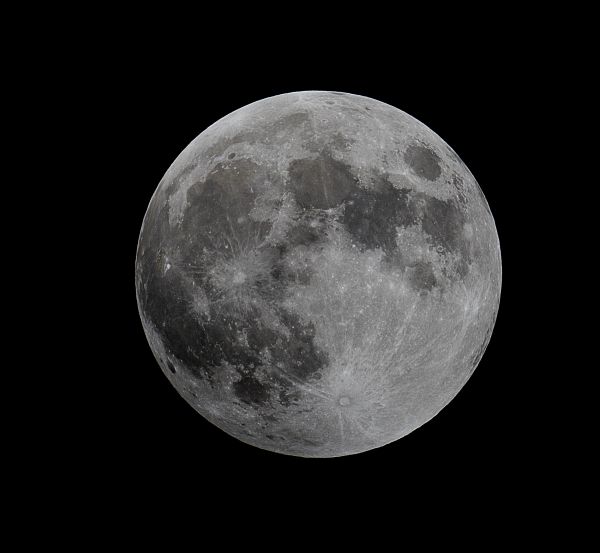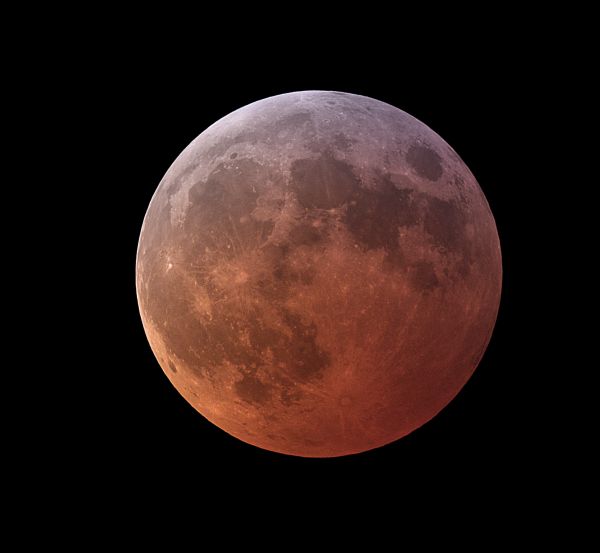The Lunar Eclipse of March 13/14, 2025 |
| In a hurry? Click here to view the eclipse gallery. Click here to view an animation (images half-sized) of the event (opens in a new window). |
| A total lunar eclipse was
visible over most of the Americas late night March 13 thru early
morning, March 14 2025. Clear skies were forecast for most of
the night, and I aimed to capture the event from beginning to
end, conditions permitting. A great resource that I use to help plan or schedule eclipse viewing is https://www.timeanddate.com, which reports timing (and even includes an animation depicting the event) for our location. According to that website, the penumbral eclipse started at 11:57PM. I made an attempt to take a nighttime nap, but I was too worked up to sleep and after about an hour of tossing and turning I decided to not even try. In addition, I recalled a software sequencer that I had used (Eclipse Orchestrator) to image solar eclipses in the past. That got me up as I decided to see if perhaps it also works for lunar eclipses. Alas, it didn’t. So, I had to manage my sequence (including bracketing exposures) manually. I had already prepared our imaging setup during the day: an Astro-Physics Stowaway (a 92mm/f6.65 refractor) with field flattener and a Canon Digital Rebel t6i. Since I couldn’t sleep and it was still early for the event (about 11am), I decided that it would be cool to follow the event visually as well. I set up a second scope for visual use: a Takahashi FC-76DCU (76mm/f 7.5 refractor). I started capturing images just before the beginning of the penumbral eclipse. Since the Earth’s penumbral shadow is very faint, the penumbral phases of a lunar eclipse are subtle at best. Which my images demonstrate. As an example, here is an image taken at 12:36AM, showing hardly any shadow (which should be visible at the lower left of the image): |
 |
|
Exposure times: 1/2000 second Digital composite assembled in Photoshop CS5 |
| My original goal was to capture the phases of the
eclipse every 5 minutes, but in practice the intervals ended up
being a little less even. What affected my process
was my attempts to properly expose the Moon in various stages of
the eclipse (I wanted to avoid over or under-exposing portions
of the Moon, which I was mostly successful at). Specifically, I
discovered that what worked in a prior moment no longer worked
the next. In addition, my goal for this eclipse (which I had
succeeded at in the past) was to capture data for creating HDR
(High-Dynamic-Range) images. This required bracketing exposures,
from as short as 1/640 second to as long as 4 seconds (all at
ISO 400) during the deeper partial phases. In addition to all
this, I did not attempt collecting HDR data during the early
phases of the Moon’s ingress into the Earth’s umbra (the darker
part of the Earth’s shadow), waiting until the Moon was at least
1/3 eclipsed before making any attempts. As you will see in the
sequence, I discovered that HDR composites are actually possible
with maybe 10% or less of the Moon in shadow. Notes for future
eclipses! On top of all this, I was manually tracking the eclipse with my visual setup. All that messed up my timing. Oh, and did I mention clouds? While the skies for the event were primarily clear, clouds would occasionally move through, which messed up some of my timing. That said, thoroughly enjoyed the event. I monitored and posted my impressions to our club’s discussion board as the eclipse progressed. Interestingly, the telescopic views through my visual setup showed little of the redness that is normally visible during an eclipse, causing me to comment to my club's chat group that the eclipse seemed darker than I remember. However, when I looked up during totality, the copper tones of a “standard” eclipse were plain as day. This amused me as I thought to myself that the eclipsed Moon, complete with the bright edges of the less-eclipsed section, reminded me of telescopic views of Mars. Which brought to mind the Mars Hoax emails. I managed to view and image the eclipse throughout its entire umbral stage and most of its exit-penumbral phase. I stopped short not too long after the last moment of partiality: according to my resources, partiality egress ended at 4:47AM, with the penumbral phase ending at 6:00AM. My last image was captured at 5:15AM, though the Moon looked mostly like a regular Full Moon at that point. That, plus the Moon was about to be blocked by a neighboring tree, was my signal that it was time to end my backyard expedition. |

Maximum eclipse. Click on the image to view at full size (opens in a new window). |
|
The image gallery can be viewed here. Note that each image in the gallery is a small preview of the full-size image. Please click on the image to view it full sized (this will open in a new window). Hover over each preview for exposure statistics. One of my goals for this event was to depict the partial phases of the eclipse in High Dynamic Range, which attempts to show photographically what the Moon looks like through a telescope. Not unexpectedly, my best results were achieved with more than two different exposures. How did I decide on the exposure times? I had the camera's live view active, and adjusted exposure time until the view through the screen was acceptable to my eyes. Which was subjective and in some instances still not perfect, as in a few of the HDR images the brighter regions of the Moon were overexposed and not fixable in Photoshop. |
|
Exposure times: 1, 1.6, 2 and 4 Seconds Digital composite assembled in Photoshop CS5 |
| Date: March 13/14, 2025 |
| Location: West Chester, OH |
| Equipment Used: Astro-Physics Stowaway APO Refractor on an Astro-Physics AP1200GTO mount. Canon EOS Rebel t6i operating at ISO 400 |
| Processing Software: Photoshop CS5 |
